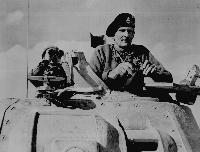
- Of El Alamein

- Of El Alamein
 Click here for larger picture.
Click here for larger picture.
Bernard Law Montgomery was born in London in November 1887. In 1907 he entered the Royal Military College at Sandhurst and rose to the tank of Lietenant by the beginning of the First World War. In the Great War he received the D.S.O ans was shot twice in october 1914, once in the chest and once in the knee. After returning to England Bernard Montgomery joined the staff and returned to the western Front in France in early 1916. At 31 years of age and Chief Of Staff of the 47th London Division. By 1939 Montgomery was given command of the 3d Division that was part of the British Expiditionary Force (BEF). He took command of the 2nd Corps at the dunkirk bridgehead and then took command of the 5th Corps in July 1940, tehn the 12th Corps in April 1941 and then commanded the South Eastern Army (covering Kent, Surrey and Sussex).
It was here that Montgomery earned his reputation for 'training, training and more training' and he raised the morale of the British Army expecting invasion after being repelled at Dunkirk. His clear thinking, organisational skills and new ideas were noted and on the 10th August 1942 Montgomery embarked for North Africa and took command of the Eighth Army.
In North Africa Montgomery was to have a huge effect upon the Eighth Army, applying the same military doctrine he had developed and applied in the South East of England. Among his immediate changes were the bringing together of the RAF and the Eighth Army headquarters which were several miles apart when he arrived. This symbolised Montgomery`s dedication to the use of combined arms in war and was one of the most significant changes he made. The RAF in North Afica and the Eighth Army were now to work together in close conjunction. Training was high on Montgomery`s priorities and he had the same efect up[on the Eight Army as upon the South Eastern Army in Britain. The Eighth Army of August 1942, like the BEF in May 1940 was extremely demoralised by the fact that it had retreated hundreds of miles accross the Desert and was now expecting an attack from a superior Army equipped with Panzers and commanded by Erwin Rommel whose reputation as the 'Desert Fox' was formidable. Montgomery raised morale by applying his doctrine of training which instills confidence and competence. He also made a point of visiting the soldiers to up morale and talking to them personally aswell as through speeches, where he promoted confidence and optimism.
30th August to 7th September 1942.
At Alam Halfa Montgomery`s first battle in North Africa, his military doctrine was to be put to the test. Rommel attacked and informed by ULTRA Montgomery was able to deduce that the attack would come from the South and an outflanking manouvre would be attempted. By carefully positioning his forces, digging in his tanks and instructing his troops as to what the battle plan was, Montgomery and the Eighth Army decisively defeated the Afrika Corps. Alam Halfa was from the British point of view, one of the best examples of Army-Air cooperation in the Western Desert1 and Rommels retreating armour was hampered by the continual bombing from the RAF and his armour sustained severe losses that it couldn`t afford.
The Battle Of El Alamein - Montgomery's Offensive.
23rd October to 4th November 1942.
At El Alamein Montgomery played a set piece tactical Battle that suited him perfectly. Rommel faced with a chronic shortage of fuel and supplies and a far numerically superior Eighth Army aswell as ill health was unable to stop the full might of Montgomery`s Army. Deception techniques, huge concentrated artillery barrages and constant air attack were key features of the Battle and by 4th November 1942 Rommel withdrew from his positions and began the long retreat to Tunisia. Montgomery continued his command of the Eighth Army as it pursued Rommel into Tunisia and linked up with the 1st Army from the Torch landings. Montgomery attacked from the South of Tunis, whilst the 1st Army attacked from the North.
High Command Disputes And Interference
Concluding thoughts on the North African Campaign